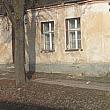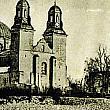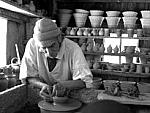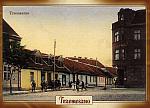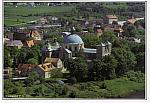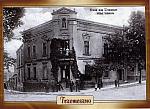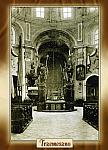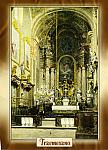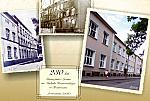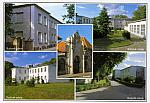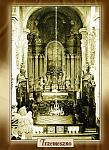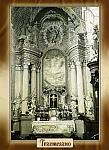Architecture of St. Adalbert's
by Eduard Adam Skendzel
The Basilica of St. Adalbert is, indeed, an architectural landmark in the Grand Rapids area. As one approaches it along the freeway from the hills both east and west of the Grand River valley, its imposing central dome gives one the impressions of some of the old cathedrals of Europe, especially that of Salzburg, Austria. No church in the State of Michigan approaches it in grandeur.
Henry J. Harks of Cleveland was the architect who designed St. Adalbert’s Church, now the Basilica of St. Adalbert. The builder was Andrews Brothers Co., also of Cleveland. The local on-the-job architect was Chris Vierheilig of St. Mary’s Parish. Originally estimated to cost $125,000, including furnishings, it actually cost $150,000—a vast amount of money in a difficult economic period. The structure, built of Sandusky limestone with Indiana Bedford limestone trim, is 194 feet in length and 80 feet in width increasing to 96 feet in the transept. The frontal towrs are 134 feet high while the beautiful huge central dome rises to the height of 150 feet above the grade line.
The architecture is basically Romanesque with the massive heavy round arch, the dominant theme and the common denominator. It is repeated throughout both the exterior and interior of the Basilica especially in the dome. The dome itself suggests a strong Byzantine influence. There is also a suggestion of Gothic in the magnificent rose window in the façade and in all the stained-glass windows, designed by A. Artmaier, and supplied by a Chicago firm employing craftsmen who had come from Munich, Germany.
The floor-plan is typical Northern Romanesque with the narthex, nave, transept, and apse, using arches and cross-ribbed vaulting. The free-standing rectangular columns and those attached to the wall are classical in design and create a unified whole. The capitals on these columns are of the Corinthian order. The four sides of each one contain sculpted heads of angels which repeat the theme of the angels on the base of the dome.
The central dome, without doubt, is the Basilica’s most outstanding feature. It immediately draws attention to the structure. Covered with copper, now jaded, [but cleaned to it original copper finish in 2010] the section viewed from the exterior soars 55 feet over the crest of the typically tiled Romanesque roof. This exterior dome forms no part of the interior dome. The octagonal cylinder of this dome is set on a square base at the four corners of which stand four clearly-outlined eleven-foot tall statues. They were sculpted from Bedford limestone, right on the site of construction, by the Gondola Brothers Co. of Cleveland, a firm of stone carvers of no small repute, trained in Italy to do the work. They represent the Angel Gabriel holding a long trumpet in his hand, each one pointing to the four point of the compass. The very pinnacle of this vast dome, in turn, is surmounted by a delicate lofty miniature dome capped by a cross.
The interior dome is decorated with geometric designs and is encircled by bands of gold, blue, and pink tracery. The four murals of angels at its base simply repeat the theme found on the exterior of the dome. The top of this interior dome in the transept, 95 feet above floor level, is climaxed by an opening, the oculus, in the top. This makes it similar to the dome of the Pantheon, built in 27 B.C. by Marcus Agrippa.
The original altars, pulpit, baptismal fount, and confessionals were designed by Edmund Verlinden. On top of the original communion rail he placed Georgia marble. The seating was made by the local American Seating Co. At the time of the consecration of the building, all the old statuary from the old church was redone by an artist, N.G. Serafini, who had come here from Europe to do such work. Originally, thousands of lights, placed on the ribs of the vaulting, lit the dome and the central and lower archers. Hundreds of other lights outline the main altar.
It is precisely the interior of the Basilica that is even more intriguing that the exterior. The beautiful marble altar underneath the lofty baldacchino* is the focal point as one enters the Basilica. Its dome and its arches and its angels simply repeat the Romanesque theme of the great central dome. This main altar is located beneath a beige ceiling flecked with gold. The paining and sculpture are all simple and severe in style with detail work which relates to icon painting. This is suggestive of the Byzantine aura about the Basilica.
The Basilica of St. Adalbert is a grand monument to the faith and heritage of Monsignor Casimir Skory and the pioneer Grand Rapids Polonians who had the vision to build such a colossal structure.
*An ornamental structure in the shape of a canopy, supported by four columns, built over a church altar, and usually decorated with statues and other ornaments.
Excerpted from The Basilica of Saint Adalbert: A GreatTemple of God on the Grand, by Eduard A. Skendzel. Grand Rapids, Michigan, 1980

 facebook
facebook